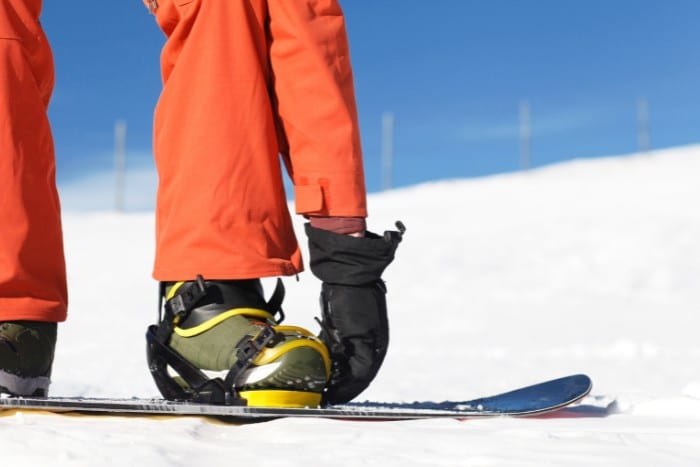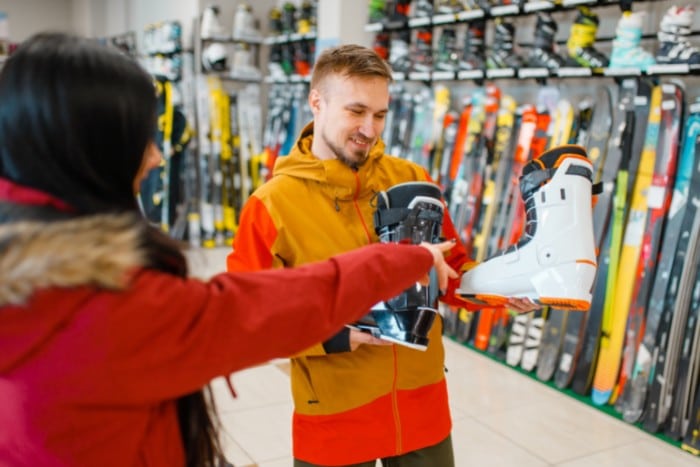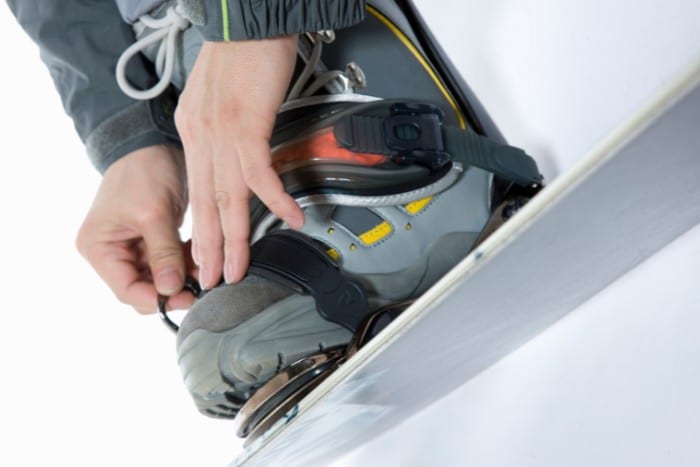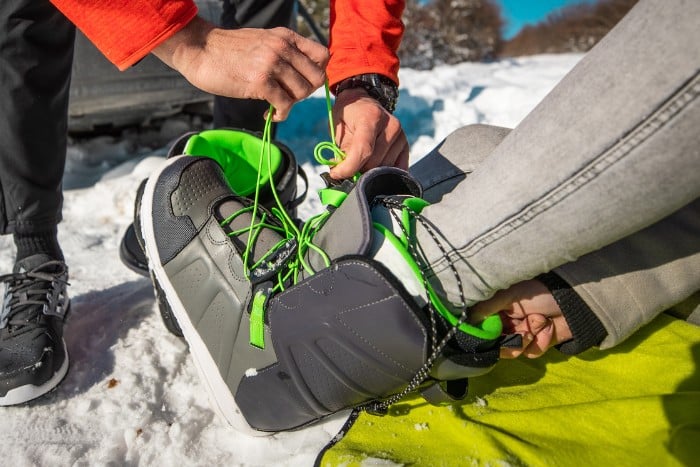Newcomers to snowboarding may think bindings are simply there to attach their feet to the board, but the truth is, they’re more complex than most people realize, and size does matter.
Snowboard boots come in different sizes and so do bindings. If a binding is too small, there’s a chance the strap may come loose, and if it’s too large, your boot may slide out. If either of these happens, you could injure yourself. There are also some types of boots that require specialized bindings.
Today, we’re going to look at why it’s important to choose your bindings carefully to avoid injury and guarantee a safe and enjoyable snowboarding experience. We’re also going to go into more detail about how binding size guides work and the different styles of bindings available.
Are Snowboard Bindings Universal?
Unfortunately, snowboard bindings aren’t universal; however, there are good reasons for this.
Bindings are what keep your feet attached to your snowboard, so it makes sense that if different people need different sizes of snowboard boots, the binding size will need to increase or decrease accordingly.
Next, we can infer that if we need to choose a snowboard with a width suitable for our boot size, then it also stands to reason that our binding choice will also be dictated by how wide our board is.
Lastly, like almost every piece of equipment in snowboarding, there’s a wide range of properties and features that may make a particular pair of bindings more suitable for freestyle riding, while another pair is going to be a better choice for racing, and yet another may be better for beginners.

Why Is It Crucial To Pick The Right Binding Size?
So, how important is it that you pick bindings based on your boot size, snowboard size, riding style, and experience? The short answer is: very.
The longer answer is that you need to remember that the bindings are the things that connect your body to your snowboard, transferring the motion and energy from your muscles into the precise movements required to ride.
Snowboarding is all about control, and even a small mistake can end in injury. Bindings, along with your snowboard boots, also provide much-needed support to your feet and ankles.
Even if your bindings fit your boots correctly, if they don’t match your riding style, you’ll struggle to enjoy your time on the mountain.
1. Board Size
If your bindings are too big for your board, or rather, your board is too narrow for your bindings, then your heels and toes are going to hang out too far over the edges of your board.
This means they’re more likely to hit the snow every time you engage an edge, causing heel or toe drag.
The best outcome here is that you might lose some speed when you’re riding, but there’s a strong likelihood that catching your heels or toes will have the same effect as catching an edge, and you’ll end up crashing.
2. Boot Size
IIf your bindings are too small for your boots, you may be able to get the straps closed, but the increased pressure on them, aside from being uncomfortable, will mean there’s a chance they might fail and snap or pop open while you’re riding.
It doesn’t take an experienced snowboarder to know this is bad news. On the flip side, if your binding is too big, then your foot might just slip straight out.
Even if you manage to secure your foot in the binding, if you have excess space around your boot, then your board won’t be as responsive to your movements, and you’ll have to work harder to engage your edges.

Choosing Bindings Based On Your Boot Size
We’ve established that you need to choose your bindings based on your snowboard boot size, but what does that look like in practice?
Generally, binding sizes are rated as Small (S), Medium (M), and Large (L), but this isn’t always the case. Frustratingly, almost every single binding manufacturer has a different sizing guide from anyone else.
Aside from having different definitions of what constitutes each size, for example, whether a Medium is a size 5-9 or a 9-11, some don’t even stick to the generic sizes.
You might find some brands offering a Small, a Medium, and a Small/Medium (S/M). Other brands, such as Gnu and Flow, call their men’s Small bindings Medium and their Large bindings Extra Large (XL).
Others, like Flux, call their women’s Small bindings Extra Small (XS) and don’t list any Medium or Large bindings.
While this might all sound unnecessarily complicated (which it is), fortunately, you can find out exactly what size binding you need by visiting the manufacturer’s website and checking out their sizing guide.
Below are some examples from a few of the most popular binding brands using US boot sizes.
Men’s Size Guide
| BRAND | S(S/M) | M(M/L) | L(L/XL) | XL |
|---|---|---|---|---|
| Arbor | 7-9 | 9-11 | 11-13+ | – |
| Burton | 6-8 | 8-11 | 10+ | – |
| Flow | – | 4.5-8.5 | 8-11 | 11-15 |
| K2 | – | 5-9 | 8-12 | 11-15 |
| Salomon | 3-7 | 6.5-10 | 10-15 | – |
Women’s Size Guide
| BRAND | XS | S(S/M) | M(M/L) | L |
|---|---|---|---|---|
| Arbor | – | 5-7 | 7-9 | – |
| Burton | – | 4-6 | 6-8 | 8+ |
| Flow | – | 4.5-6.5 | 6-10 | 9.5-12.5 |
| Flux (GS) | 4-6.5 | 7-9.5 | – | – |
| Union | – | 4-6.5 | 7-8.5 | 9-11 |
As you can see, the disparity in sizing between different manufacturers is huge. What one brand would consider a Medium may even be an Extra Small to another.
Additionally, the sizing guide might not apply across every model offered by a brand.
For example, we listed the size recommendations for the women’s Flux (GS) bindings above, but those for the Flow (GX) bindings are different again.
However, as long as you double-check each brand’s sizing guide, it’s hard to go wrong.
Choosing Your Board Size Based On Your Bindings
As we mentioned above, it’s critical that your bindings are the right size for your snowboard and don’t overhang the edges too much.
While it might seem natural to pick your snowboard first, it’s actually the last thing you should buy.
To start, you’ll need to figure out your boot size, then you can work out how big your bindings need to be, and then you can find the right board.
While new snowboards don’t come with bindings included, if you’re buying online, you might be offered a few different binding options to choose from based on your boot size and riding preferences.
However, a snowboard’s width can be dictated by more than just the rider’s boot size. Shorter boards are better for sharp turns and are usually preferred by freestyle snowboarders.
If you’re a snowboarder with large feet who needs bigger bindings, there are still ways you can make use of a narrower board.
By widening the angle of your bindings, so your feet point out towards the tips of your snowboard, called the “duck stance,” you can reduce the amount your boots and bindings overhang the edges of your board.
The other way you can make bigger bindings work with a narrower board is by picking a pair with an adjustable heel cup that lets you reposition your boots in relation to the footbed.

Choosing Bindings Based On Your Skill Level
While it might just seem like bindings are simple bits of gear designed to keep your board strapped to your feet, the truth is they’re a lot more complex than most people give them credit for.
If you’re new to the sport, picking the right bindings might be the difference between an enjoyable experience or finding the already tough learning curve is more like a learning wall.
Beginners should make sure they opt for bindings that are comfortable with a good amount of cushioning on the straps and highbacks.
As a novice, you’re going to need to concentrate on the motions that become second nature to advanced riders. If your bindings are causing you discomfort, it’s going to be harder to focus on what you’re doing.
You’re going to pick up a few bumps and bruises as a rookie, so there’s no point adding any extra pain to the experience.
The other thing to factor into your binding choice is the all-important flex. Both boots and boards have varying amounts of flex that will affect your ride, and bindings are no different.
Stiffer bindings are more responsive; while this might sound like a good thing, it means there’s less room for mistakes as every little move you make will be transferred from your body to the board.
Beginners are better off with medium-to-soft flex bindings that are more forgiving.
Choosing Bindings Based On Riding Style
Flexible bindings are also better for freestyle snowboarders as they allow more room for error and better shock absorption when landing jumps and tricks and make it easier for tweaking grabs.
More flexible bindings and boots are also better for buttery flatland tricks and jibbing.
They offer more maneuverability and control at slower speeds, much in the same way that looser trucks affect turning on a skateboard.
For those who prefer the all-mountain experience, splitting their time between the park, piste, and backcountry, a medium-to-soft flex is a better choice.
The stiffer your bindings, the more efficiently energy will transfer to your board.
This means that for hardcore racers and freeriders, stiffer bindings give the greatest amount of responsiveness, allowing for long, smooth carving at maximum velocity.
Lastly, while they’re fairly uncommon, some snowboarders use bindings that are closer in nature to ski bindings and are paired with hardshell snowboard boots.
These are usually only used by downhill racers, sometimes called alpine racing.
However, recently they’re becoming popular with splitboard riders too as the boot and binding style make it much easier when using the two halves of the board for cross-country skiing.
Does The Type Of Snowboard Boot Matter?
For the most part, the type of snowboard boot you use won’t affect the type of binding you choose; however, there are a few exceptions. Snowboard boots vary in a few different ways.
While there are three different lacing systems available, including traditional laces, speed laces, and the Boa system, none of these impact the kind of bindings you can use with them.
Freestyle boots tend to be the most flexible style of snowboard boot, with freeride boots the stiffest and all-mountain boots rating somewhere in between but again, these can still be used in combination with any binding.
That being said, the boots we’re referring to are all standard, soft-style snowboard boots that the vast majority of riders use.
While rare, some boot variants are hard and almost completely stiff and more akin to ski boots.
For the most part, these are used by hardcore racers who want complete responsivity; however, some split boarders are also adopting the hardboot style.
Hardboot bindings are closer in design to ski bindings, and the rider steps into the binding, pushing down to secure their feet in place. Softboots won’t work in hardboot bindings, and vice versa.

Does The Type Of Snowboard Binding Matter?
Aside from the lack of interchangeability between softboot and hardboot bindings mentioned above, there is another type of binding that won’t work with regular snowboard boots.
Overall, binding types can be split into three categories: strap-in, rear-entry, and “step on.”
Strap-in bindings are the most common type you’ll find, where the rider places their boot into the footbed of the binding and secures their foot using two straps: one over the ankle and one over the toes.
The straps are secured using a ladder and ratchet system. Rear-entry bindings are a bit more technical and generally more expensive.
Here, the ankle and toe straps are conjoined and usually only adjusted once. The highback of the binding is the part that folds back so the rider can slide their boot in before securing it back into place.
There are a few pros and cons to each. Rear-entry bindings are quicker for getting your board on, but the rider usually needs to be standing up to use them, so they’re not ideal for beginners.
Strap-ins are more likely to fail and can get clogged up with ice but are usually lighter and cheaper.
Regular snowboard boots work with both strap-in and rear-entry so whichever you pick is down to personal preference.
The final style of binding we have is the “step on” binding, or rather, the Burton Step On binding. These are proprietary bindings from Burton, arguably the biggest name in snowboarding.
With a pair of these, you simply have to step onto the footbed, and the boot clicks into place at the heel. When you want to release the boot, you just flick the lever next to the heel.
However, aside from being a great deal more expensive than most strap-in and rear-entry bindings, they also require specialized Burton boots.
Conclusion
While most styles of snowboard boots work with the two most common types of binding, that doesn’t mean bindings are one-size-fits-all equipment.
Bindings come in different sizes depending on your boot size to guarantee a comfortable fit and safe snowboarding experience.
On top of that, racing boots may use ski-style bindings, and Step On bindings can only be used with specific Burton boots.
